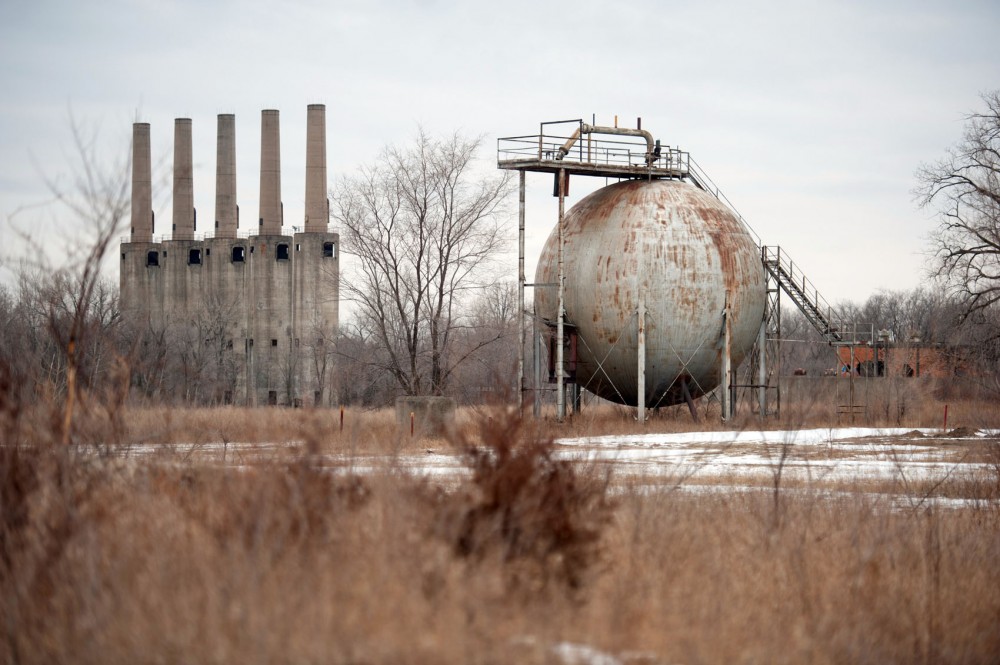A 426-foot tall wind turbine buzzes distantly above fields of grass and thorns scattered with crumbling buildings about 25 miles outside Minneapolis.
The Eolos Wind Research Station in Rosemount, Minn., was among the first green facilities at the 5,000-acre University of Minnesota Outreach, Research and Education Park. It will not be the last on the University’s path to develop a green 30,000-resident community, a project cast nearly 30 years into the future.
A group of faculty and students propose to install an intelligent electric grid, or Smart Grid, at UMore to power the town.
The proposal, headed by Massoud Amin, director of the University’s Technological Leadership Institute, and four graduate students, was first introduced to UMore’s planners in 2010. Details were published in February.
The University’s energy plans for UMore include the use of green sources like wind, heat and solar power to avoid straining Dakota County‘s power grid.
Amin, who coined the term Smart Grid in 1998, envisions a smart, self-healing energy grid for UMore and the University campus. The idea is to build a community producing as much energy as it consumes and minimize reliance on fossil fuels.
Homes hooked to the Smart Grid would have green appliances, power stations for charging electric vehicles and in-home meters for residents to track their energy usage. Technology for each home would cost in range of $10,000 to $28,000.
A Smart Grid can use wind and solar power, allow people to more easily report technical problems like power outages and defend itself against cyber-attacks.
If there were disruptions to the grid, like a power outage, it would isolate the problem to allow everyone else to get back up and running faster until the issue is resolved, said Wanda Reder, a vice president of S&C Electric Company.
In conjunction with green power sources, Smart Grids use batteries to provide power during times when the weather changes.
“The sun doesn’t shine all the time, and wind doesn’t blow all the time,” Reder said.
Aside from assessing a Smart Grid for UMore’s proposed 30,000 homes and commercial buildings, Amin also hopes to implement the technology at the University’s Twin Cities campus.
Many universities and military bases are taking advantage of independent power grids, Reder said, as technology shifts to being self-contained.
The 2007 Energy Independence and Security Act passed by Congress outlines the country’s development of a smart power grid. Smart Grids are being deployed across the country, Reder said.
The University has a “unique opportunity” to draw upon its science and engineering programs to build an efficient and environmentally friendly energy grid in UMore and the school’s campuses, Amin said.
Past to present developments
The University obtained UMore’s land in 1947 from the federal government. Since then, many of the school’s departments have used the site for research.
The land used to be occupied by farmers, but families started leaving their homes in 1942 as the federal government prepared the site to be used by Gopher Ordnance Works, a munitions factory producing smokeless powder for the war effort. But World War II ended before the facilities could be used.
In 2008, the University’s Board of Regents reviewed the first concept plan for the self-sustainable research community on the site. The plan put the project’s completion 25 to 30 years in the future.
In June 2011, the Board of Regents forged a lease agreement with Dakota Aggregates, LCC for gravel mining at UMore. In October 2011, Rosemont’s city council purchased 27.5 acres of UMore property from the University to turn into baseball fields.
The Smart Grid proposal has been presented to UMore’s project planners. The school’s UMore master plan was last updated in 2009, and new proposals have yet to be integrated.
The road ahead
The University’s vision to build a sustainable community in UMore has many steps in front of it, said Carla Carlson, UMore Development LLC’s vice president of operations.
The University’s vision divides UMore into six districts with different features and landscapes adjacent to the Vermillion Highlands, a 2,822-acre research, recreation and wildlife area south of the park. Each district is designed for walking and cycling through its commercial and residential centers.
Before any homes or power grids can be built at UMore, there needs to be a review of the infrastructure required to develop a city and comprehensive amendments to the University’s plans, said Carlson.
Amin expects the process of working with the city of Rosemount on permits will take the University through the end of 2013.
Another hurdle is the housing market, which has been down in recent years. The University doesn’t want to take on unnecessary risks, said Carlson.
“We can’t predict when things will improve,” she said.
In the meantime, University faculty and students have been studying a “wide range” of options for technology and infrastructure, she said. The school considers these contributions to see how well they would fit with its plans.
When it comes to the proposed Smart Grids, the University will align its strategy with future technological advances, and its plans may be enhanced over time, she said.
“The market is king.”











